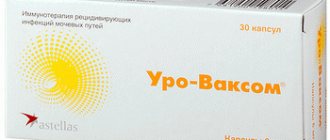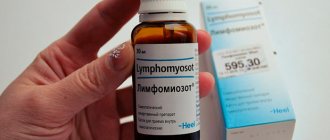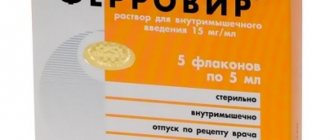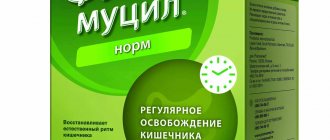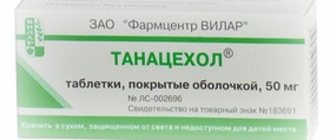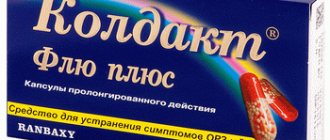Compound
- Sublingual tablets - dry purified sea buckthorn leaf extract, cocoa powder, vanillin, refined sugar, sodium carboxymethylcellulose, calcium stearate.
- Hyporamine, lyophilized for solution preparation, is a sterile extract from the leaves of sea buckthorn.
- Hyporamine ointment - extract from sea buckthorn leaves, petroleum jelly, vinylin, nipagin, Tween-80, eucalyptus oil, medical emulsifier, sterile water
- Rectal suppositories - extract from sea buckthorn leaves, solid fat type A.
- Vaginal suppositories - extract from sea buckthorn leaves, vaseline oil, solid fat type A.
Release form, composition and analogues of Giporamin
Hyporamine containing dry purified extract from sea buckthorn leaves as an active component is produced in several dosage forms:
- 0.5% homogeneous grayish-white external ointment, in tubes of 20 g;
- Gray sublingual tablets, 20 mg;
- Plant raw materials;
- Rectal and vaginal suppositories 50 mg;
- Lyophilisate for the preparation of a solution for inhalation and intranasal administration, 20 mg.
In some cases, especially against the background of hypersensitivity to the active substance, one of the analogues of Giporamin with a similar mechanism of action is prescribed: Bonafton, Lomagerpan, Condilin, Alpizarin, Devirs, Vivorax, Gossypol, Acigerpin, Acyclovir, Erazaban, Gervirax, Imiquimod, Oxolin, Helepin- D, Epigen intimate, Fenistil Pentsivir, Aldara, Epigen.
Pharmacodynamics and pharmacokinetics
Pharmacodynamics
A preparation based on an extract from sea buckthorn leaves. the drug are represented by a polyphenolic complex of galloellagitannins , which have an antiviral effect against various influenza viruses ( strains A and B ), paramyxoviruses , cytomegaloviruses , adenoviruses , herpes zoster viruses , respiratory syncytial virus . The mechanism of action of Giporamin is based on the inhibitory effect on viral neuraminidase .
The inhibitory effect of the drug on the process of viral reproduction is manifested at all stages of reproduction. The drug promotes the production of interferon in the blood of patients. Hyporamine has a moderate antimicrobial effect against bacteria, tuberculous mycobacteria, and some filamentous fungi. The drug is low-toxic and does not have mutagenic, allergenic, carcinogenic or teratogenic effects, and does not affect the patient’s immune status.
Pharmacokinetics
No data available.
special instructions
Before you start using the medication, you should pay attention to several special instructions:
- For therapeutic purposes, it is recommended to start using the drug at the earliest stages of the disease. During this period, active replication of viruses occurs, which significantly increases the effectiveness of the drug.
- One tablet contains a small amount of carbohydrates, which should be taken into account in patients with concomitant diabetes mellitus type 1 or 2.
- The drug and its active components do not affect the functional state of the cerebral cortex, therefore, during the course of therapy, it is allowed to perform potentially dangerous work that requires increased concentration and speed of psychomotor reactions.
Indications for use
The drug is prescribed to adults and children from 2 months for the prevention and treatment of adenovirus infection , influenza (strains A and B), respiratory syncytial infection and other acute respiratory infections , parainfluenza , zoster , all forms of herpes of genital and non-genital localization, tonsillitis due to acute Acute respiratory infections, viral respiratory diseases with rhinitis, cytomegalovirus infection and viral diseases caused by pathogens sensitive to the drug.
Hyporamine during pregnancy and lactation is taken in consultation with a doctor.
Possible contraindications
If you are pregnant, you should definitely consult your doctor. Although no negative aspects were found during testing, no one guarantees 100% safety for the child. Therefore, doctors do not prescribe Giporamin to pregnant and lactating women. In such cases, ointment is prescribed, but only after a thorough analysis of the fetus and the health of the mother
Also, the use of the drug is strictly prohibited for children under 3 years of age or if the patient has hypersensitivity to any of the components.
Basically, the drug has passed all studies and the occurrence of contraindications is very rare.
Hyporamine, instructions for use (Method and dosage)
The drug is recommended to be prescribed in the early stages of the disease. For influenza , acute respiratory infections of various etiologies and other viral diseases of the respiratory tract, take: adults, 1 tablet up to six times a day; at the age of 3-12 years - take 0.5-1 tablets, and over 12 years - three times a day, 1 tablet. Take the drug for 3 – 5 days. Sanitation of the oral cavity is carried out by taking sublingual tablets (keep under the tongue until completely absorbed).
For herpes zoster , herpes infection , chicken pox and other lesions of the mucous membranes and skin by the virus: adults and children over 12 years of age, take 1 tablet up to six times a day. The period of admission depends on the type and severity of the disease and ranges from 3 to 10 days for mild cases and 2-3 weeks for severe and recurrent cases. The course of treatment is repeated if necessary.
In order to prevent herpes and cytomegalovirus infections, patients after surgical interventions are prescribed 1 tablet three times a day for a week.
The ointment is applied topically to lesions of the mucous membranes and skin up to five times a day for 3-10 days in mild forms and 2-3 weeks in recurrent and severe forms. Repeated courses of treatment are carried out if necessary.
Rectal and vaginal suppositories are prescribed to adults, depending on the severity of the disease, 1-2 times a day.
Hyporamine for inhalation in the form of an aqueous solution is administered through inhalation devices to adults - up to 10 ml of a 0.2% solution per inhalation; children under 12 years old - 0.1% aqueous solution.
Hyporamine in the treatment of ARVI in children
About the article
2183
0
Regular issues of "RMZh" No. 21 dated October 29, 2005 p. 1404
Category: General articles
Author: Afanasyeva I.A.
For quotation:
Afanasyeva I.A. Hyporamine in the treatment of ARVI in children. RMJ. 2005;21:1404.
Treatment of acute respiratory viral infections (ARVI) remains a pressing problem today. According to WHO, every third person on the planet suffers from ARVI every year. More than 30 million cases are registered in Russia every year. This group of diseases is especially common among children. Moreover, young children - from 1 year to 5 years - are most often affected, and the greatest susceptibility to viral infections is between the ages of 6 months and 3 years. In general, the share of ARVI is at least 70% in the structure of childhood morbidity. Among viral diseases, influenza occupies one of the first places in terms of the number of people involved in the epidemic process. In addition to children, the special risk group includes people over 65 years of age, patients with immunodeficiencies, as well as patients with chronic respiratory diseases (bronchitis, emphysema, bronchiectasis, etc.). If treatment for influenza is started incorrectly and untimely, there is a high likelihood of complications developing. It is children who often have a severe course, the greatest number of complications and deaths. Repeated influenza diseases lead to the formation of chronic bronchopulmonary pathology in children, contribute to the development of tonsillitis, otitis, sinusitis, sensitize the body and change its reactivity, reduce or change general and local immunity, and can cause delayed psychomotor and physical development. In addition, influenza is highly contagious and can become epidemic, especially in children's groups. In preschool institutions, the incidence is observed throughout the year with an increase in frequency in the autumn-winter and spring months.
The causative agents of acute respiratory diseases in children in the vast majority of cases are respiratory viruses. But we should not forget about the importance of bacterial flora, mainly streptococci (Streptococcus pneumoniae, group A b-hemolytic streptococcus). Less commonly - other types of streptococcus and staphylococcus, Haemophilus influenzae, Moraxella catarrhalis, representatives of the group of intestinal gram-negative bacteria (such as Escherichia coli, Klebsiella, etc.), fungi (usually the genus Candida) and anaerobes. Recently, the role of intracellular pathogens (mycoplasma, chlamydia) has increased. The etiology of acute respiratory infections also depends on the age of the child: a viral-bacterial and bacterial nature is more often observed in newborns, infants and young children, while in older children it is predominantly of a viral nature. The most common symptoms of ARVI in children are nasal congestion, runny nose, lacrimation, pain and sore throat, cough, deterioration in general health, which is accompanied by anxiety, moodiness, loss of appetite, sleep disturbance, increased breathing, and increased body temperature. For a long time, vaccine prevention was considered the most effective means of combating ARVI. However, the effectiveness of these measures, for example, against influenza, is limited by the antigenic variability of different strains, and even highly effective vaccination against influenza alone does not guarantee protection against the entire group of acute respiratory viral infections. In addition, there are difficulties in covering an epidemically significant part of the population with preventive vaccinations. The effectiveness of various chemotherapy drugs in the prevention and treatment of acute respiratory viral infections has been recognized. Among the drugs used for influenza, priority goes to etiotropic drugs that have a direct antiviral effect that disrupts various phases of the replication cycle of viruses. They are divided into 2 groups: M2 channel blockers and neurominidase inhibitors. The first group includes the well-known rimantadine. The disadvantage of amantadine derivatives is toxicity, the presence of a therapeutic effect only in the early stages of the disease in influenza A and lack of effectiveness in influenza B. In addition, their widespread use leads to the emergence of resistant strains of the virus. Not all of the modern antiviral drugs can be used in childhood and pregnant women. This circumstance emphasizes the need to create fairly harmless antiviral drugs for the treatment of adults (including pregnant women) and children that do not cause the development of viral resistance. Recently, herbal medicines have become widespread. The advantage of these drugs is that the biologically active substances of plants are more naturally included in the metabolic processes of the human body than synthetic ones, which means that there is better tolerability and a less frequent development of side effects and complications. One of these drugs is Giporamin - a new original development of the All-Russian Institute of Medicinal and Aromatic Plants (VILAR), a highly effective herbal drug that combines antiviral, interferon-inducing and antibacterial effects. Hyporamine is approved for use in adults (including pregnant women) and children from 2 months of age. The active ingredient of Giporamine is a dry purified extract from the leaves of sea buckthorn (Hippophae rhamnoides L.) of the family Eleagnaceae, which is a polyphenolic complex of galloelagotannins, the biologically active components of which are hydrolyzable tannins. Hyporamine has antiviral activity against various strains of influenza A and B viruses, adenoviruses, paramyxoviruses, herpes simplex viruses, Varicella zoster (shingles and varicella zoster virus), cytomegaloviruses, respiratory syncytial virus and has an inhibitory effect against gram-positive and gram-negative bacteria, tuberculous mycobacteria, fungi of the genus Candida. The mechanism of action of Hyporamin is realized intracellularly. It is based on an inhibitory effect on viral neuraminidase. This enzyme, which is part of influenza virions, hydrolyzes the glycosidic bond connecting the keto group of N-acetylneuraminic acid with sugars. As a result of suppression of viral neuraminidase, virion assembly is disrupted and thus viral reproduction is disrupted. In addition, Hyporamine induces the production of interferon in blood cells in in vitro experiments; at concentrations of 1000, 100 and 10 μg/ml it has high virus-neutralizing activity, completely neutralizing 1000 EID (experimental infectious doses) of the influenza virus (strains A and B); in in vivo experiments it has a high virus-inhibiting effect (at a dose of 4 mg/embryo it completely inhibited 1000 EID of the influenza A virus); inhibits the growth of some gram-positive and gram-negative microorganisms (Staphylococcus aureus, Escherichia coli, Proteus vulgaris, Pseudomonas aeruginosa, Micobacterium tuberculosis, Microsporum canis, Candida albicans) at a concentration of 31.2–250 μg/ml. According to the results of toxicity studies, Giporamine (with a single intraperitoneal and intragastric administration to four species of animals) belongs to the category of low-toxic substances. In therapeutic doses, it does not have a damaging effect on the main organs and systems, does not have allergenic, mutagenic, locally irritating, embryotoxic or teratogenic properties. Clinical studies of Giporamin were conducted at 9 clinical sites. The study involved 625 inpatients, including 251 children with acute respiratory viral infections (influenza, parainfluenza, adenoviral and respiratory syncytial infections, as well as mixed infections), including those occurring with obstructive syndrome or pneumonia. It was found that treatment with Giporamine contributed to a significant reduction in the duration of clinical manifestations, such as cough, rhinitis, fever, laryngeal stenosis, and wheezing in the lungs. Also, the administration of Giporamin to 78 children suffering from acute respiratory viral infections, complicated by laryngeal stenosis of 1-2 degrees or obstructive bronchitis, led to a significant reduction in the duration of the main clinical symptoms (temperature reaction, shortness of breath, stenosis, hoarseness) and length of hospital stay. Studies have shown good tolerability of Hyporamin in all studied dosage forms: in both adults and children, no toxic manifestations of a general or local nature were observed and no abnormalities were identified according to clinical and laboratory tests (blood, urine, liver tests, etc. ). Indications for use and treatment regimens with Giporamin: Giporamine is used in adults and children (aged 2 months and older) as a therapeutic and prophylactic agent for: – influenza (A and B); – parainfluenza; – respiratory syncytial, adenoviral and other acute respiratory viral infections; – tonsillitis and rhinitis occurring against the background of ARVI; – acute and recurrent forms of herpes simplex of extragenital and genital localization; – herpes zoster, chicken pox; – cytomegalovirus infection. For influenza, adenovirus, respiratory syncytial or other viral infections of the upper respiratory tract, the following are prescribed: sublingual tablets of 0.02 g. Sublingual tablets are used for sanitation of the oral cavity, for which they are kept in the mouth for complete resorption. In this case, adults are prescribed 1 tablet. 4–6 times a day, children over 12 years old, 1 tablet. 3–4 times a day, children from 3–12 years old, 1/2–1 tablet. 2–4 times a day (depending on age). For children under 3 years of age, tablets are dissolved in water and given as a solution. For parainfluenza, RS-viral, adenoviral, mixed infections and other acute respiratory viral infections, take for at least 5 days. For individual prevention during an influenza outbreak, hyporamin sublingual tablets are used. Thus, the safety and effectiveness of Giporamine make it possible to use this drug for the prevention and treatment of acute respiratory viral infections in children, and the combination of various properties provides a wide range of its therapeutic effectiveness in the clinic. Literature 1. Ershov F.I. Antiviral drugs. Directory. M.: Medicine, 1998. 2. Boyko N.V. Respiratory diseases in pediatric practice 2001. 3. Uchaikin V.F. Diagnosis, treatment and prevention of influenza and acute respiratory diseases in children. A manual for doctors. Moscow, 2001 4. Airborne infections. St. Petersburg, IKF “Foliant”, 2000. 5. Sokolov S.Ya., Zamotaev I.P. Handbook of medicinal plants. Moscow, 1993 6. Tatochenko V.K. Respiratory diseases in pediatric practice. 2001 7. Vidal reference book. Medicines in Russia. M, 2004
Content is licensed under a Creative Commons Attribution 4.0 International License.
Share the article on social networks
Recommend the article to your colleagues
Analogs
Level 4 ATC code matches:
Vekluri
Remdeform
Areplivir
Coronavirus
Avifavir
Triazavirin
Arpeflu
Yodantipyrine
Flavoside
Amizon
Altabor
Anaferon for children
Anaferon
Amiksin
Arbidol
Ferrovir
Tiloron
Kagocel
Isoprinosine
Allokin-Alpha
There are no structural analogues of the drug.
Drugs with similar therapeutic effects - Alpizarin , Arbidol , Amiksin , Ingavirin , Viracept , Kagocel , Yodantipirin , Nikavir , Lavomax , Ergoferon , Oxolin and others.
Hyporamin price, where to buy
The price of Giporamin tablets No. 20 varies from 130 to 169 rubles per pack. You can buy Giporamine in most pharmacies in Moscow and other cities.
- Online pharmacies in RussiaRussia
ZdravCity
- Hyporamine tablets sublingual.
20 mg 20 pcs. CJSC "Pharmcenter VILAR" 138 rub. order

